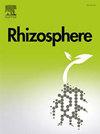AMF and DSE diversity and colonization characteristics of Salvia miltiorrhiza in different genotypes and growth periods
IF 3.4
3区 生物学
Q1 PLANT SCIENCES
引用次数: 0
Abstract
Salvia miltiorrhiza is a significant traditional Chinese medicine commonly utilized in the treatment of cardiovascular and cerebrovascular diseases. However, its application and development are hindered by issues related to mixed genotypes and the content of medicinal ingredients not meeting the standards. Arbuscular mycorrhizal fungi (AMF) and dark septate endophytes (DSE) are representative symbiotic fungi that show great potential for improving the growth and quality of S. miltiorrhiza. In this study, we examined the effects of genotype, growth period, and rhizosphere soil factors on species diversity, community composition, and colonization characteristics of AMF and DSE using morphological characteristics and molecular identification techniques. The results indicated that different genotypes and growth periods of S. miltiorrhiza could be colonized by AMF and DSE, although variations existed in the structure and sites of colonization. A total of 93 AMF strains from 11 genera and 35 DSE strains from 19 genera were isolated and identified. Among them, Glomus and Acaulospora were the dominant genera among AMF, while Alternaria alternata and Macrophomina phaseolina were common dominant species in DSE. Variance partitioning analysis indicated that the three-way interaction of genotype, growth period, and soil factors accounted for the highest percentages of AMF and DSE species diversity, at 58.06 % and 62.26 %, respectively. Two-factor analysis of variance indicated that both AMF and DSE species diversity exhibited a trend of October > August > March, with genotypes Z3 and Z4 demonstrating higher species diversity and segregation rates compared to Z1 and Z2. Correlation analysis shows that the main soil factors affecting the diversity of AMF and DSE include pH, SOC and NH4+-N. In conclusion, this study not only enriched our understanding of the symbiotic relationship between S. miltiorrhiza and endophytic fungi (AMF and DSE), but also deepened our knowledge of their ecological functions. Furthermore, it provided a theoretical foundation for the isolation and conservation of endophytic fungal germplasm resources, as well as their subsequent application in the cultivation of Chinese medicinal materials.
不同基因型和生育期丹参AMF和DSE多样性及定植特征
丹参是一种重要的中药,常用于治疗心脑血管疾病。但基因型混杂、药用成分含量不达标等问题阻碍了其应用与发展。丛枝菌根真菌(AMF)和暗隔内生真菌(DSE)是具有代表性的共生真菌,在改善丹参生长和品质方面具有很大的潜力。本研究利用形态特征和分子鉴定技术,研究了基因型、生长期和根际土壤因子对AMF和DSE物种多样性、群落组成和定殖特性的影响。结果表明,不同基因型和生育期的丹参均可被AMF和DSE定殖,但定殖位点和结构存在差异。共分离鉴定AMF 11属93株,DSE 19属35株。其中,Glomus和Acaulospora是AMF的优势属,而Alternaria alternata和Macrophomina phaseolina是DSE的常见优势种。方差划分分析表明,基因型、生育期和土壤因子三者交互作用对AMF和DSE物种多样性的贡献率最高,分别为58.06%和62.26%。双因素方差分析表明,AMF和DSE物种多样性均呈现10月和10月的变化趋势;在8月3月,基因型Z3和Z4的物种多样性和分离率高于Z1和Z2。相关分析表明,影响土壤有机质和土壤有机质多样性的主要土壤因子包括pH、SOC和NH4+-N。总之,本研究不仅丰富了我们对丹参与内生真菌(AMF和DSE)共生关系的认识,而且加深了我们对其生态功能的认识。为内生真菌种质资源的分离、保存及其在中药材栽培中的应用提供了理论依据。
本文章由计算机程序翻译,如有差异,请以英文原文为准。
求助全文
约1分钟内获得全文
求助全文
来源期刊

Rhizosphere
Agricultural and Biological Sciences-Agronomy and Crop Science
CiteScore
5.70
自引率
8.10%
发文量
155
审稿时长
29 days
期刊介绍:
Rhizosphere aims to advance the frontier of our understanding of plant-soil interactions. Rhizosphere is a multidisciplinary journal that publishes research on the interactions between plant roots, soil organisms, nutrients, and water. Except carbon fixation by photosynthesis, plants obtain all other elements primarily from soil through roots.
We are beginning to understand how communications at the rhizosphere, with soil organisms and other plant species, affect root exudates and nutrient uptake. This rapidly evolving subject utilizes molecular biology and genomic tools, food web or community structure manipulations, high performance liquid chromatography, isotopic analysis, diverse spectroscopic analytics, tomography and other microscopy, complex statistical and modeling tools.
 求助内容:
求助内容: 应助结果提醒方式:
应助结果提醒方式:


